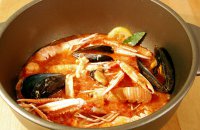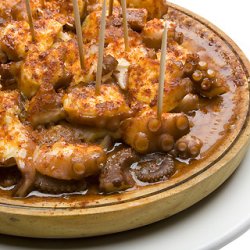While the tradition for most Europeans is to eat cheese after the main course at lunch or dinner, for Greeks, cheese need not be a meal supplement; it can be a meal by itself. In Italy, cheese is typically served as an appetizer; take “Mozzarela al pesto” or fresh parmesan with olive oil and rocket, for instance. In France, cheese is savored as the first phase of dessert. In England, unless your fellow diners are cosmopolitans, the question of whether cheese will be before or after the meal is almost comical. You will be lucky if you find quantities of the ingredient in more than a sprinkling during your entire dining experience.
On the contrary, in Greece, cheese is eaten all the time. Sometimes it is eaten alone, as it is. Other times it is either fried or cooked, as the main ingredient in a variety of dishes. There are many cheese delicacies, the best known of which is the “tyropita,” or cheese pie, our national snack. We serve different variations of this in every bakery, every bread store, every coffee shop, every restaurant, and every supermarket. We export this dish frozen in huge quantities internationally. There are even “Tyropitadika,” or shops that sell nothing but cheese pies and their derivatives, scattered throughout the country.
Your average usually starts off off his day with a mild or salted cheese for breakfast, probably soft or semi-hard and probably accompanied with a cup of coffee. Whether working in an office, in the fields, or going to the beach, he will then have as a cheese snack- perhaps a thick slice on its own, maybe on a piece of bread, or maybe as a tyropita
.
At lunchtime, cheese will always be on the table. At tavernas, feta cheese is brought to the table before anything else, even before the wine. We have cheese with the first dish, the second, and of course the salad; there’s nothing like feta cheese with Greek tomatoes. Dinner will probably be similar. Then, before bed, your average Greek will most likely have yet another cheese snack. Probably feta cheese with melon. Graviera cheese with “soultanina” grapes is another favorite.
An explanation for our humorously excessive cheese-eating habits might be the fact that Greece was a very poor country for many centuries, especially under Turkish occupation. In urban areas, meat, poultry, and fish was so scarce that such meals had to be substituted with something cheaper and with equal nutritional value- something like cheese.
Conversely, the people living in the country or on the islands had a surplus of backyard chickens, rabbits, goats and sheep. The goats and sheep would produce more milk than the villagers knew what to do with. As a result, the townspeople would turn the superabundance of milk into cheese as a preservation technique. Today, Greeks rank first throughout Europe in cheese consumption, with a whopping dozen of kilos per year per person.
Read here the History of Greek Cheese
Check out our following with cheese :
Tiropitta
Figs with cheese
Grilled Squid Stuffed with Feta Cheese
Greek Salad - Horiatiki
Greek Cheesecake with Katiki and Xinomyzithra
Sweet Crustless Pie with Angel Hair Pasta, Milk and Cheese (Pigoulopita)
When Greeks Say Cheese
As a cultural tradition originating during the centuries of deprivation under foreign occupations, the prevalence of cheese within today's Greek cuisine is almost comical.
Country:
Category:
Related Articles
Most Popular recipes


































































